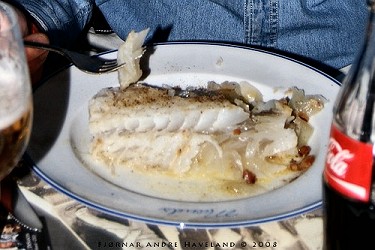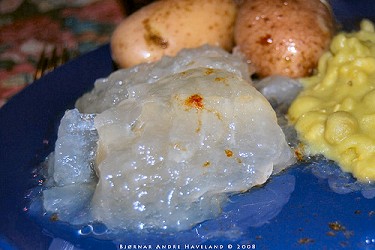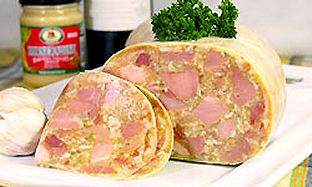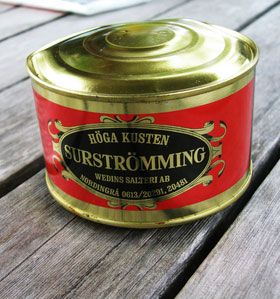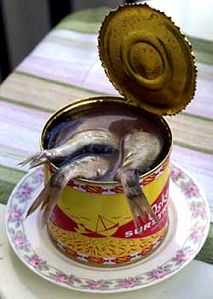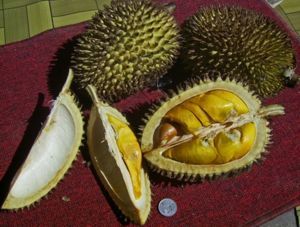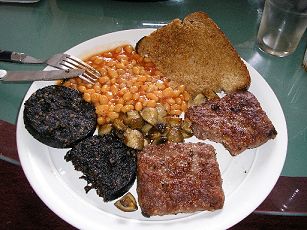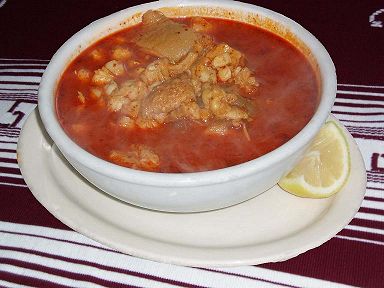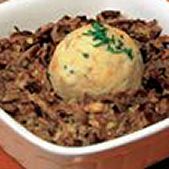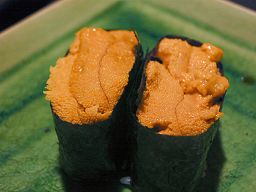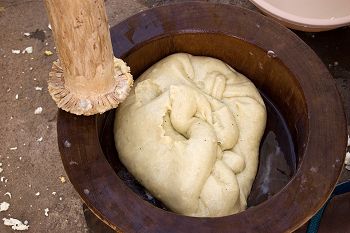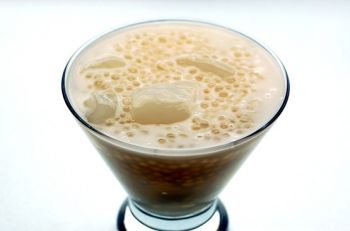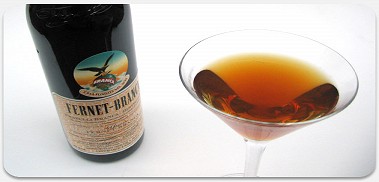From a Cave in the Woods...The "High Culinary Inquisitor*" brings you...The Old Wolf's Banquet from Hell |
One man's meat is another man's
poison, so they say. And world over, people love strange foods. Or
else they eat them to stay alive. As Crocodile Dundee said, "You can live on it,
but it tastes like
![]() ."
."
Having travelled extensively throughout Western and Eastern Europe, the Middle East and Africa - along with a single, all-too-short visit to Australia - I have been confronted with a number of things that many people would consider inedible. And by Mogg's tufted tail, I've come to like most of them. It comes down to eating what's in front of you or offending your hosts... and believe me, in some of these countries you don't want to offend your hosts: Hell hath no fury like an angry Albanian. On the other hand, some of these foods I've worked on learning to enjoy, because it didn't come naturally. But it's been worth the journey. To include all the jokes that have been made about the menu items on the Banquet from Hell would require more storage space than my ISP allows... but let the world mock. For the most part, they have no idea what they are missing.
It goes without saying that there are things out there, enumerated within the dark underbelly of the internet, that are far stranger than the foods listed below. This page is not about the bizarre and twisted (although some might take exception to that) - hence balut, kopi luwak, casu marzu, various insects and things equally repulsive are not found here. For this reason. Similarly, there are many foods which others would include, but which are common enough that they don't merit mention here - roadkill food (possum, beaver, squirrel, etc.), snails, frogs' legs, caviar, Spam™, foie gras, gefilte fish, and so on.
So here, for your gratuitous enjoyment, is the Old Wolf's Banquet from Hell: a compilation of things that people in faraway places consider delicacies. For additional viewing pleasure, I've included a key:
![]() I hunt for this and will eat it at the drop of a hat.
I hunt for this and will eat it at the drop of a hat.
![]() Never tried
it, but I'm looking forward to the chance.
Never tried
it, but I'm looking forward to the chance.
![]() I'd rather be
dipped in bees. Only for large money would I eat this again.
I'd rather be
dipped in bees. Only for large money would I eat this again.
Haggis

|
"Fair fa' your honest, sonsie face, Great Chieftan o' the pudding-race! Aboon them a' ye tak your place, Painch, tripe, or thairm: Weel are ye worthy o'a grace As lang's ma airm." (Robert Burns)
|
Haggis is the undisputed king of the Banquet from
Hell. The fact that it's composed of things that most people throw
away, and cooked inside another thing that everyone throws away,
tends to be off-putting. But if you get to know this beautiful
gift from heaven, you'll thank fortune for the opportunity. Haggis is a blend of oats and sheep's pluck - liver, heart, and - if you live in the UK - lungs, which are not legal to be used in the USA. Plus onion, fat, spices, and salt. While reminiscent of liverwurst in flavor (toda raba, Solomon Bock!), it has a unique quality that grows on you. In America it can be purchased in cans, in vegetarian versions (blasphemy!) or frozen, usually packed in a commercial sausage casing rather than the sheep's stomach. I understand in the UK it's a simple matter to get the real thing. Sigh. |
Nattō

|
|
A dear friend of mine told me after looking at
Nattō that food isn't supposed to have cobwebs
in it. Well, for the most part, she's right. But if you can
get past a texture that's similar to gallstones mixed with
rubber cement, Nattō is a gourmet's dream. I was introduced to Nattō because my ex-wife served a mission in Japan. When I discovered that this culinary delight was something that even most Japanese turned their noses up at, I knew at once that I had to try it. For me, it was love at first bite. All it is, really, is fermented soybeans. Hey, fermented is good - at least, that's what my beer-drinking friends tell me. There's a slight bitterness about Nattō, too, but it just adds to the interesting experience. What can I say? I really, really like Nattō. I get a chuckle out of the response from Japanese waiters when I ask them if they have any in back. Most of them come back with "you really like that stuff?" Some even hang around to see if I'm going to eat it... For an even more brain-curdling treat, learn about "Smutto". |
|
|
Pronounced "haukatł"
- with that peculiar Navajo "L" sound - this Icelandic treat
is one that I approach with some trepidation. From the Wikipedia
article:
There is no shortage of pages on the internet that describe how totally Satanic this preparation of fermented shark actually is. Yet the Icelanders continue to make it, and eat it. It may be a plot by the brennivin industry to bolster the need for consumption, but I won't be satisfied until I can try it for myself. If I ever get the chance to visit Iceland, I'll return and report. Provided I survive... |
Huitlacoche

|
|
Typically when things go moldy, you throw them
out. In the case of huitlacoche, or Corn Smut, however, that's the
right time to harvest it. One pundit who runs a blog said
"These results can also be achieved by bombarding a kernel of corn
with gamma rays and then making it angry." Not a bad
description. I'm told that the infected kernels are good when they are fresh, much like mushrooms. In fact, huitlacoche is often called "maize mushrooms", and it is a fungus. However, I've only ever been able to obtain Huitlacoche in cans, pre-cooked, by which time it has gone black and looks like nothing more than a concoction of black pinto beans. The first time I actually got to try it was at a Mexican restaurant in San Diego, as part of a variety of appetizers, and was very favorably impressed. So much so that I wondered what all the fuss is about. Howard Tayler of Shlock Mercenary came up with an interesting thought... I'm sorry I wasn't the first one to think of it: Smutto - and you can see some being made here. |
Kimchi

|
|
The cartoon by Chip Dunham above says all there is to say about kimchi, if you're one of the unfortunate souls who doesn't care for it. So sad... Some people just don't appreciate a fine concoction of cabbage, peppers and garlic left to moulder under a compost heap for 7 years. Wait, what am I saying?! I like kimchi! Up to 3,000 years old, kimchi... wait, that's not coming out right. The history of kimchi can be traced back up to 3,000 years, with the earliest version being not much more than Korean sauerkraut, cabbage left to ferment in brine. Later additions and refinements (yes, you can refine rotting cabbage) have resulted in over 180 varieties of kimchi, dependent on locale, available ingredients and regional preferences. While there is some debate on whether an excess of nitrates, salt and alliums might contribute to gastric cancer, most sources list kimchi as a healthy food, high in vitamins and fiber, and low in calories. One unavoidable downside is that if you eat a lot of it, you're going to have garlic breath. Worth the price... |
Sauerkraut

|
|
While more common and well-known than kimchi,
sauerkraut (literally "sour cabbage") still falls under the rubric
of "stuff you're supposed to throw away" for many people.
However, unlike natto to the Japanese, sauerkraut is almost
universally loved in Germany and many other parts of Europe. Sauerkraut is cabbage that has been fermented in brine. It can be eaten raw or cooked - kraut with caraway seeds that has been sautéed in bacon fat until it's soft might be death to the arteries but it's sheer heaven to the palate. As a side dish to a huge, golden Wienerschnitzel, along with Spätzle (German gnocchi) and Gurkensalat (cucumber salad), it's totally unbeatable. |
Fermented Bean Curd or
"Pickled Tofu"

|
Fermented Bean Curd or Pickled Tofu |
Always on the lookout for
tasty things that don't have a lot of calories or which aren't high-glycemic, I stumbled across fermented bean curd in a Korean grocery
while I was looking for coconut cream and taro root for
another recipe. Took it home and tried some. Hey, I like tofu,
I like pickled things, how much different could it be? The first thing I noticed was the consistency of the liquid it was packed in. I immediately thought of artgum erasers marinated for a century in camel snot. Not an auspicious beginning. OK, out come the hashi and we try a cube.
I wanted tasty, I got tasty. The jar didn't last long, but the stuff makes my nose run every time I eat it, it's so potent. Maybe I can patent this as an antihistamine. At any rate, this food is a winner in my book, although like Vegemite, it's best in small quantities. These days I use it in sparing quantities as an adjunct to other foods, much like wasabi. |
Buttermilk

|
|
Once when I was about 6 or so and visiting an
aunt out in the country, my mother made the mistake of using
buttermilk for hot chocolate. The trauma may have been responsible
for the wrongness of my brain when it comes to food. Whatever
the case, I refused to touch the stuff for another 15 years or so. When I got to college, and noticed that the food line at the dorm had buttermilk as an option, I decided that I was going to learn how to like it, because so many of my relatives kept telling me I was missing something. So every day for a month, I gagged down a half-pint of buttermilk with my meals. And at the end of the month, I was not only not dead, but had succeeded in my intention. Now I'll take a glass of ice-cole buttermilk over Dr. Pepper if it's available, and that's saying something. Gosh darn it, my relatives were right. This paid additional dividends when I began spending time in Turkey for work purposes. There, ayran (very similar to buttermilk but made with thinned yogurt) rivals the sale of juice and soda, and my enjoyment of it earned me massive points with my Turkish associates. Similar drinks are also found in Iran (doogh) or Armenia (tahn); I also found "Fermented Milk" in Norway, which was nothing more than buttermilk, and very good. Incidentally, if you ever make your own butter - which is a snap with a Kilner Butter Churn - what you have left when you've extracted the butter is real buttermilk, rather than the cultured variety. For heaven's sake, don't throw it away! |
Lutefisk

|
Lutefisk if you're lucky...
Lutefisk if you're not... Images ©2008 by Bjørnar Haveland |
Lye is used for cleaning drains and making soap.
It's extremely caustic and highly toxic. Its name should not even be
whispered in the presence of food. And yet it's the principal
catalyst in the production of lutefisk
(lye fish), a Norwegian delicacy which I am now privileged to pass
my own judgment on. For a humorous piece on Lutefisk written by Clay Shirky, click here. The Verdict The Lutefisk I had at Mauds restaurant (Tollbugate 24, Oslo, now sadly closed) was a sheer delight. First of all, it was served piping hot. Second, it tasted like... fish! Well, duh! And the flavor was delicate, neither too salty nor too fishy. Third, the texture was softer than poached salmon, for instance, but not the liquified glop I was led to expect. Shirky's description of the experience sharing a meal with Norwegians was fairly accurate - my colleagues also had porkchops, ribs, and other very yummy-looking things, and made supportive noises while apologizing for only eating Lutefisk once a year. Being teetotal, I declined the Aquevit... As described, my fish was served with boiled potatoes, a bowl of mushed peas, mustard, and a little dish of bacon fat and bacon bits to garnish it with. I tried it plain, with the potatoes and peas, with the bacon drippings, and with the mustard. I got totally stuffed on the huge portion of fish that was served me, and then the waiter wanted to know if I was ready for the other half...
(Thanks to Katja Frost for the buttons!) I'm a fan... and I'll
be going back to Mauds! |
Preßwurst

|
(With apologies to Mr. Cranky) |
Recipe for making
Preßwurst: "Sweep up a butcher shop floor at the end of the day. Be sure to include the sawdust and bits of bone you find lying around. Dump sweepings in a pot of boiling water, add gelatin derived from 500 cows, and boil vigorously for an hour. Pour into molds, chill, and cut with a chainsaw into slices. Serve, and leave at once for other lands." In German, it's called "Sülze". In Denmark, it's "Sylte". Go to Norway, it's called "Ogudjegmåkasteopp". English has no obscenity foul enough. "Head cheese" is what they call it, and if I'm reminded of a certain limerick about a hermit from Wales, it's no coincidence. For the longest time, I was told as a child, "Try anything once - if you don't like it, you don't have to eat it." So when I was living and working in Austria, and Preßwurst was served to me, of course I tried it - I didn't want to offend my hosts. It was like eating spiced gristle encased in rubber. After that first bite, I surreptitiously hid the blasphemy under a lettuce leaf, the only time I have refused to eat something that was served me. I think my hosts would have been more offended by the results had I tried to down the rest of it. And remember, this review has been brought to you by someone who enjoys lamb's guts boiled in a stomach and necrotic cabbage. Lasciate ogni speranza, voi che mangiate! |
Surströmming

|
|
As everyone knows, it is a federal crime to bring
explosives onto an airplane. For this reason, surströmming is
no longer available in the United States. A northern Swedish delight
consisting of fermented Baltic herring, it is packaged in cans.
When the can looks like a football, it's ready to eat. One Norwegian said, "Earlier this summer I stayed at a Swedish-run hotel in Norway - I believed something was wrong with the plumbing, but it was only the Swedes having a surströmming feast in the kitchen." This is unusual, because typically Swedes are smart enough to eat surströmming outdoors - when the cans are opened, the fermentation can spray liquid up to six feet. Happily, those who have survived the experience say that the flavor of surströmming is reminiscent of the Vietnamese nước mắm (fish sauce), but only after one has gotten past the smell. According to Stephen Fry (see link below), one helpful trick is to open the can under water to avoid the spray, and then rinse the fish before eating it. Links:
Wikipedia
article on Surströmming |
Vegemite

|
|
The mistake most people
make when trying Vegemite for the first time is using way, way too
much of it. They'll spread it on bread as thick as peanut
butter or jelly, and wonder why their mouth puckers for the next
three weeks. Any Australian worth his or her weight in cockatoo feathers will tell you that you spread it very thinly on buttered bread. And if you take their advice, it's indescribably good. It's a meaty, earthy taste almost reminiscent of beef bouillion. Yeast is a fungus, after all... and if you give it a chance, this one will grow on you. And grow. And grow. The only drawback to Vegemite is that as an import, it's pretty pricey. But don't worry, a little jar goes a long way. This lone accomplishment -
not to mention all the other wonderful things that Australia is
responsible for - amply atones for the misdeeds of their original
transportees.
Ozzie! Ozzie! Ozzie! Oi! Oi! Oi! (By the way, if you hear rumors to the effect that Vegemite has been banned in the USA, ignore them - it's an urban legend, as Snopes.com will confirm.) |
Gamalost

|
|
Once again the Norwegians
score a place on the menu for the Banquet from Hell. Gamalost means
"old cheese", and one of my colleagues (a Norwegian) told
me that it smells worse than Limburger. So here's my experience. I got the little box I had purchased in Oslo home and opened it up, expecting an eye-searing blast of foulness. Nothing. Hm, I wonder if this cheese is defective. Encouraged, I got my nose down in it and took a big whiff. Still nothing. Just a faint hint of ammonia, reminiscent of Camembert crust. (To be fair, this was store-bought gammalost, and not something they put down behind the outhouse the day the Gokstad ship was buried, so perhaps I'm only getting second-rate product...) Wow, maybe this stuff is edible after all. Still, I learned my lesson about being too bold when you try something for the first time ... my first Sushi experience saw me eat an entire mound of Wasabi at one time, so this time I just picked up a tiny bit on a knife and gingerly tasted it. Holy Mother of Mogg... when the ground stopped moving, and after my ears stopped ringing and my eyes uncrossed, I understood why they say what they do about gamalost. The flavor is indescribable. No, not rotten, but very cheesy, very sharp, with that ammonia edge, and something else that I haven't found an analogy for (yes, I have smelled pig manure, thank you), almost earthy. By the time I work my way down to the bottom of the tub, I'll be hooked. You can hear Øystein Sunde, one of the four Gitarkamaratene (guitar friends) sing a wonderful song about gamalost on YouTube, along with the Norsk lyrics and an English translation.
Wikipedia article
on Gamalost |
Durian Fruit

|
|
Wikipedia describes durian
fruit as follows: "Widely known and revered in Southeast Asia as the
"King of Fruits" ... the edible flesh emits a distinctive odor,
strong and penetrating even when the husk is intact. Regarded by
some as fragrant, others as overpowering and offensive, the smell
evokes reactions from deep appreciation to intense disgust. The odor
has led to the fruit's banishment from certain hotels and public
transportation in Southeast Asia." On the other hand, regarding the flavor, British naturalist Alfred Russel Wallace famously described its flesh as "a rich custard highly flavoured with almonds". Durian is available in the USA if you know where to look. I scored some fresh, hulled fruit at the 99 Ranch Market in Las Vegas; I have now experienced Durian for myself, and the report follows. It's smelly. Merciful Mogg, it's smelly. I understand why it's been banned in public from certain locations. I drove from Las Vegas to Salt Lake with some fresh durian in my car, which promptly began smelling like... like... well, it took me about an hour to figure it out, because I was thinking "I've smelled that before..." Then it hit me. The closest I can come is the stuff you scrape out of a pumpkin at Hallowe'en, with a soupçon of necrotic flesh added - but definitely a pungent, fruity smell instead of the rotting garbage I had been led to expect. After about 4 hours my nose stopped registering it altogether, which was a blessing, because the smell changes in characteristic as you stay around it longer, and is quite overpowering. I even tend to suspect that what I purchased was only semi-ripe, and that the smell would have been worse had it been fully ready. The whole durians at the store had very little odor - I watched one lady pick one up and smell it, and then put it down again - not because it smelled bad, but because it didn't smell bad enough! Needless to say, I was a bit hesitant to try it, but once again I was surprised. The flavor is nothing like the smell (as has been reported by others) - very sweet, with a nuttiness around it - not almonds to my taste buds, but something else which I can't put my finger on. So durian gets a thumbs up to eat - I would certainly enjoy it if it were served at a dinner - but I don't especially care for the smell. |
κοκορέτσι (kokoretsi)
|
|
Ah, Greek haggis! Despite
trips to Greece, Turkey and Albania, I never encountered kokoretsi (kokoreç
in Turkey, kukurec in
Albania) until recently. Perhaps my colleagues never mentioned it,
fearing I would find it unpalatable. I include it here because it
sounds divine, and I can't wait to try it. From Wikipedia, "Kokoretsi is a dish of the Balkans and Anatolia consisting mainly of lamb or goat intestines (think sausage casings, folks), often wrapping seasoned offal, including sweetbreads, hearts, lungs and/or kidneys. The intestines of suckling lambs are preferred. ... The ingredients are cut up and seasoned with lemon, olive oil, oregano, salt, and pepper. The intestine is cleaned especially thoroughly. The filling meats are threaded onto a long skewer and wrapped with the intestine to hold them together." |
Black Pudding

|
|
Black pudding is also
called "Blood Pudding". Good name, because that's all it is.
Blood, and not much else. This is enough to make it off-limits to
observant Jews and Jehovah's Witnesses, who follow the Biblical
injunction to avoid eating blood (which contains the life-essence).
It should be enough to make it off limits to anyone but vampire
bats, but interestingly enough, many people in savage and untamed
parts of the world (such as the UK and Ireland) find it tasty. I was served black pudding when I was staying at B&B's in Ireland, as part of the full Irish breakfast that tourists seem to crave. I scoffed the lot and gained about 29 lbs - if you think McDonald's is greasy, you're sadly mistaken - and found it not distasteful to the palate, but I still have a hard time getting my head around what I was eating. Hence the flashing traffic light. Yes, I would eat it again if it were served to me. No, I won't go looking for it. The white pudding (pork meat and fat, suet, bread, and oatmeal) was easier to eat just because it was made of parts of the animal that are usually consumed. |
Callos


|
|
Here are the ingredients
found in one version of this typical Spanish delicacy: Ox tripes, water, pig snout, morcilla (lard, blood, hog jowl and pork loin, onions, salt, peppers, smoke flavor, oregano, lactose, dextrose, milk solids, spices: carrageenan, garrofin gum, xanthan gum) chorizo (hog jowl and pork loin, water, peppers, lactose, dextrin, sugar, milk solids, salt, garlic, smoke flavor, preservatives), onion, spanish pork lard, tomato, white wine, wheat starch, carrots, celery, salt, spices. If you like Menudo (see below), you'll love Callos! How strange to be eating offal and finding it addictively good... but there it is. I'm not even going to look on the can to seen how many calories are in this stuff... *Belch* |
Menudo


|
|
Mexican Menudo comes in
different varieties, especially a red and a white one. The
basis of both, however, are beef tripes. The kind I enjoy has
tripe and hominy, and it's delicious. Robust, hearty, filling
and savory, this would be a perfect meal on a cold day, accompanied
by hot corn tortillas and a picante salsa. The tripes themselves have very little flavor, taking on whatever the soup is spiced with. In consistency they're more solid than the fatback you find in pork and beans, but less robust than muscle meat. |
Beuschel

|
|
Beuschel (Calf-organ Stew) - Austria This is the first thing I saw for sale in the ÖBB Betriebsküche (Austrian Railway Cafeteria) as I stepped off the train in Villach, Austria in February of 1975. I didn't have a chance to try it until later that winter when I was living in Innsbruck, and it was served to me by a most wonderful family living in Hall in Tirol, on a bed of steaming spätzle. Following my rule of trying anything once, I bravely tucked in, and found it heavenly. The strangest thing about it is the sponginess of the lungs - but that was easy to overlook. Here's a recipe: Beuschel Put the lungs and heart of a calf into a soup kettle and barely cover with water. Add sliced carrots, an onion, a bay leaf, thyme, cloves, peppercorns, and a generous amount of salt. Simmer until the meats are tender. Prepare a lightly browned butter-and-flour roux and brown in it a pinch of sugar. Add some of the stock and beat into a smooth sauce. Add a mixture of chopped anchovies, lemon peel, capers, gherkins, garlic, onion, and parsley. Simmer for about 20 minutes. Add the heart and lungs cut into thin strips and heat through. Add some prepared hot mustard and lemon juice. Correct the salt, pepper, and sugar. Stir in some sour cream and serve with dumplings. This recipe was found via GoogleBooks in a volume entitled Unmentionable Cuisine, which provides recipes for a whole raft of strange things to eat, including the Ayran mentioned above. Interestingly enough, I was served a similar dish in my ancestral village of S. Pietro Apostolo (CZ), Italy, by a beloved relative now passed on. They called it "u morzellu"... it was based, unsurprisingly, on a tomato sauce rather than an organ-meat gravy, and it was delicious. |
Uni

|
|
From SushiFAQ.com: "Uni
(oo-nee) is the Japanese name for the edible part
of the Sea Urchin. While colloquially referred to as the roe (eggs),
uni is actually the animal's gonads (which produce the milt or roe).
Uni ranges in color from rich gold to light yellow, and has a creamy
consistency that some love and is off-putting to others. It is
nevertheless one sushi item that is in incredible demand around the
world, which is reflected in its price. Sea Urchins are a rare treat
for those who acquire a taste." Note: The status of this item has changed from Sadly, I'm not one of them. I tried Uni once, and though I'm a huge fan of almost all other kinds of sushi, this one just about killed me. It was like eating sludge that had been dredged from the bottom of Narragansett Bay. Briny. Muddy. Salty. Nasty. Am I a hypocrite for liking raw octopus, squid and other sorts of fish, rotten soybeans and organ meats boiled in a stomach, and turning up my nose at a highly-sought-after delicacy like sea urchin gonads? Could be. I'd suffer the scorn of nations before I'd eat Uni again.
Update: Since adding Uni to "The Banquet From Hell", I have been told by many friends and associates that I may have gotten bad uni. Some of these are people I trust implicitly (Danny, you know who you are) - so if I ever find myself in a sushi bar, feeling the effects of a testosterone overdose and cojones of solid rock, I may - note, the operative word is "may" - be willing to try it again. As a mentor of mine likes to say, "Huh. We'll see." Update 2: It was bad Uni. Really bad. I bit the bullet and tried it in another restaurant, and the difference was galactic. Still the taste of seafood, but not toxic mud. Now I'm a fan. |
Fufu

|
|
This is one of the plainest foods I've ever eaten. I experienced
this delight in the Democratic Republic of Congo, but it's eaten all
over Africa and in other places in the world. While it is often made
of plantain flour, yams, or cornmeal, or a combination of these
starches, in the west of the DRC it tends to be made exclusively of
manioc (cassava) flour, which we know as tapioca.
(Tapioca pudding has a special place in
many people's personal Banquets from Hell... something about
eating fish eyes is what I remember, or muttered comparisons to what
you get when a baboon is unwell. As for me, I love it. And some of
the best tapioca pudding I have ever eaten was served to me when I
was a guest in the refectory of
Assumption Abbey, all praise to their borscht and scones!) It has many names: ugali, nshima, sadza or posho... but in Congo, it's fufu. The recipe is simple: Add boiling water to flour, and mix or pound until it's dough. Done. In the Congo, it is taken from a community bowl, rolled into balls and used to dip up whatever happens to be on the menu, thus serving as both food and utensil. Manioc fufu has an unusual flavor if you're not used to it. Served with chicken moamba, antelope, plantains fried in red palm oil and boiled greens under a palm frond roof in the middle of a bustling section of Kinshasa, it's positively exotic. I have since made it at home, and prefer mine with about a 50/50 mix of cornmeal and manioc. Incidentally, if you make fufu with straight cornmeal, what you get is polenta, or a close approximation. My thanks to Georges Kingoma and Kwambo Mbaki for introducing me to this delight. |
Fernet-Branca

|
Fernet-Branca |
Let's not forget something
to drink with our "Banquet from Hell". Possibly the foulest
thing that has ever entered my mouth from the normal direction is
Fernet-Branca, an alcoholic bitters made in Milan, Italy. Having
heard of its virtues as a digestif, I took it one night while at the
opera house in Naples, because I was developing an upset stomach and
didn't want to have to leave the production, which was good - so I
thought it would be worth a try. Some people like the fact that it's made with a base of 80-proof grape spirits, but the proprietary blend of herbs and spices make it taste like pine tar and cod liver oil, with just a hint of burned tires (best description I've ever heard of it, unless you've ever had the joy of retching up pure bile.) Why such a concoction was ever invented is beyond me. The only item in the plus column is that it did settle my stomach. Which is strange, for something that tastes so repulsive. There is one thing about Fernet to be grateful for. Now that I'm teetotal, I won't have to worry about deciding whether to try it again. Ever. |
*Title bestowed by Howard Tayler, author of "Schock Mercenary".
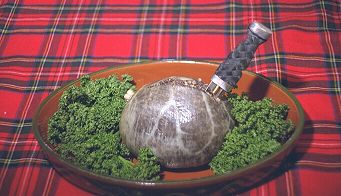

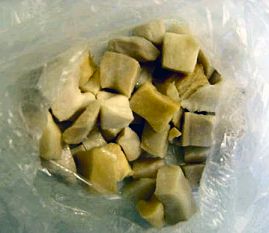
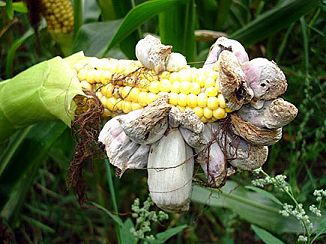

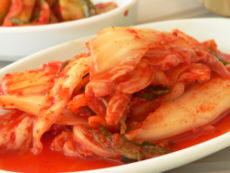


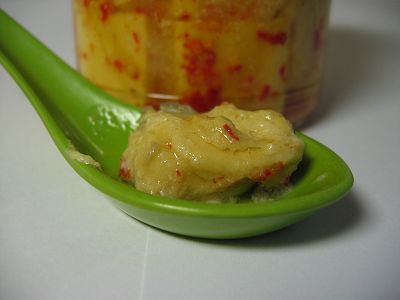
 By
the sacred skull of Mogg's grandmother, what was that? Not
fiery, although there are some peppers in the recipe. Not especially
salty, although there is a touch of salt. Not sour, like vinegar.
Distilled Zing is the best I can come up with. Almost as if
it were hyper-carbonated, enough to make my tongue think it had been
dipped in boiling liquid CO2.
By
the sacred skull of Mogg's grandmother, what was that? Not
fiery, although there are some peppers in the recipe. Not especially
salty, although there is a touch of salt. Not sour, like vinegar.
Distilled Zing is the best I can come up with. Almost as if
it were hyper-carbonated, enough to make my tongue think it had been
dipped in boiling liquid CO2. 
